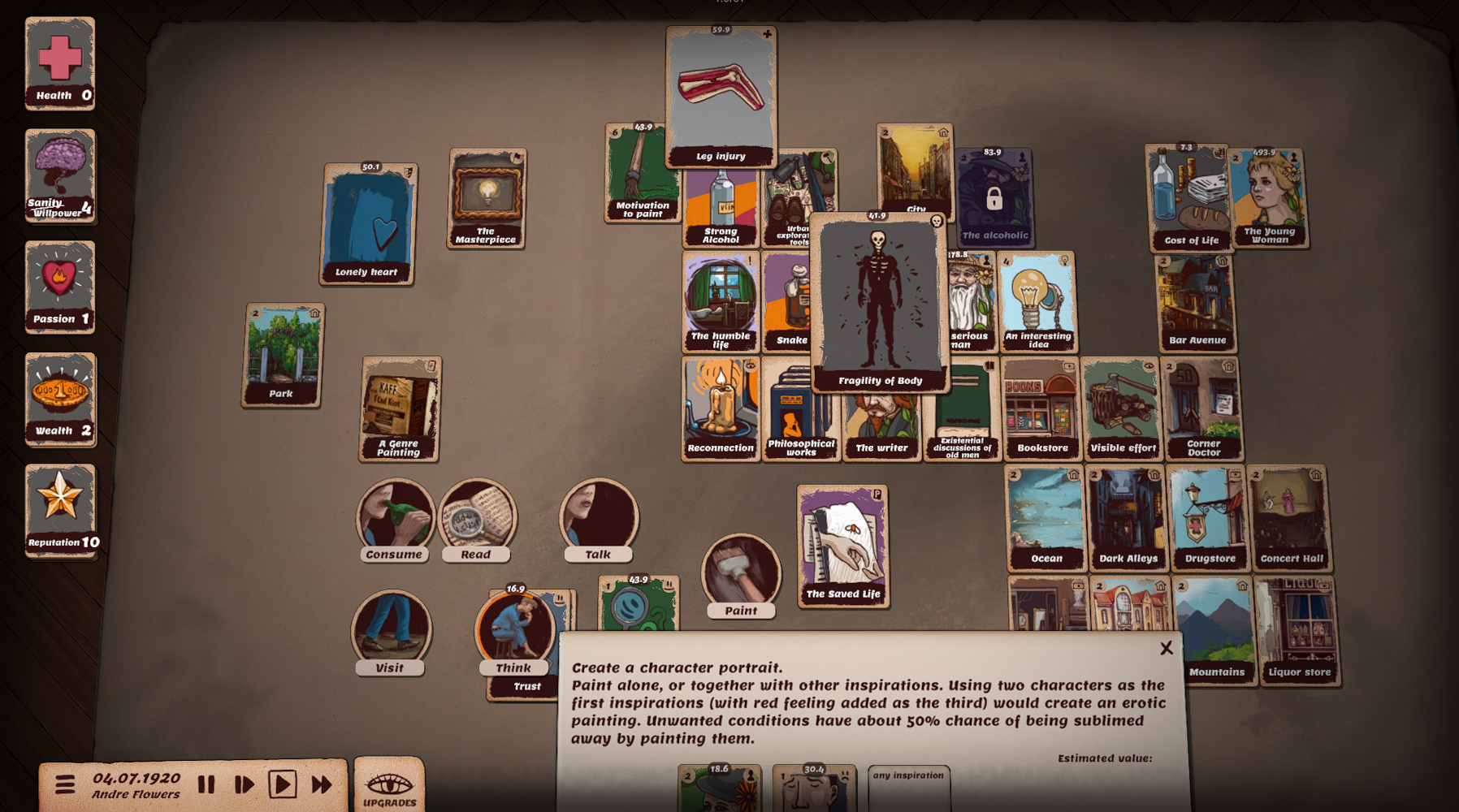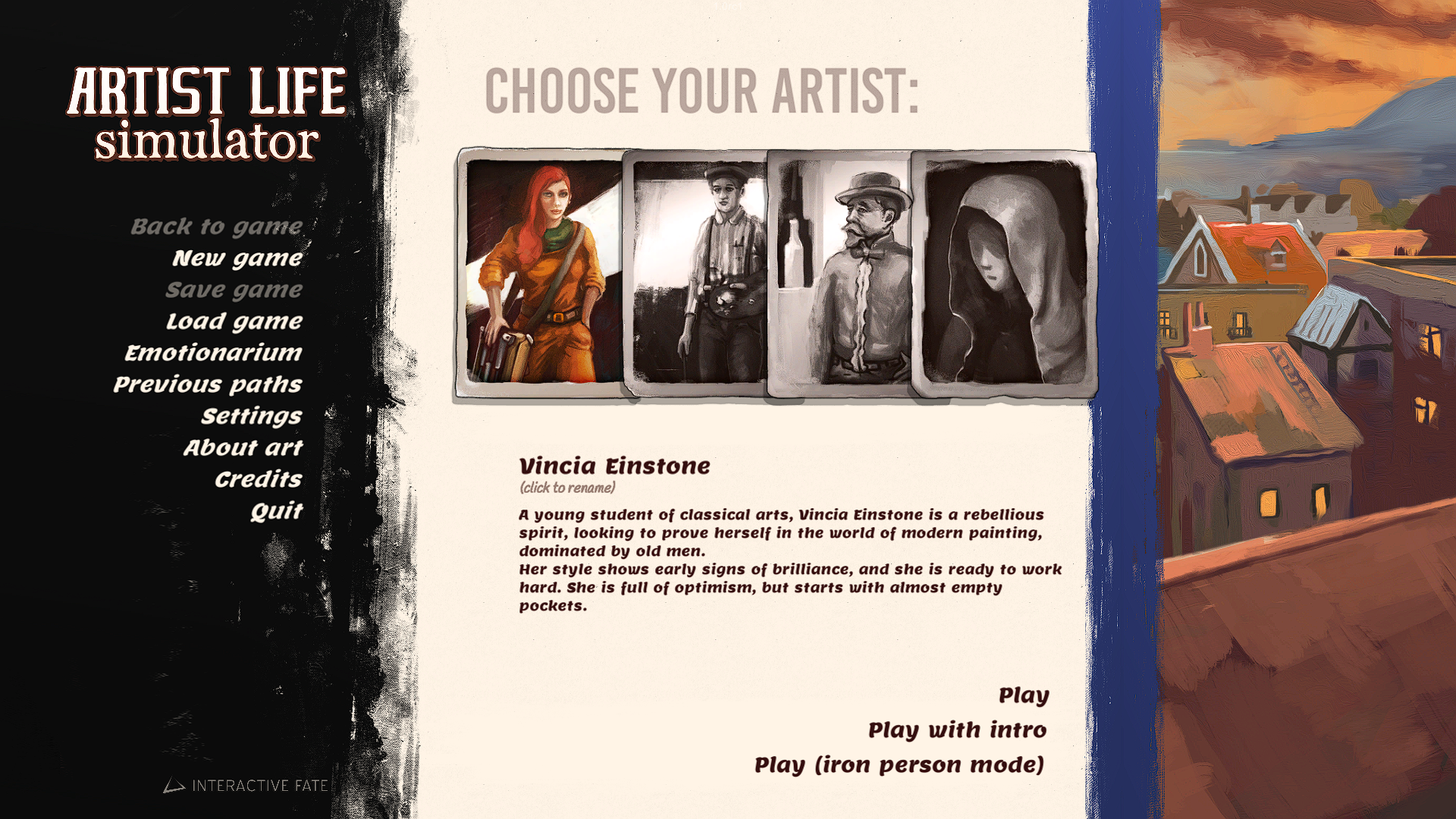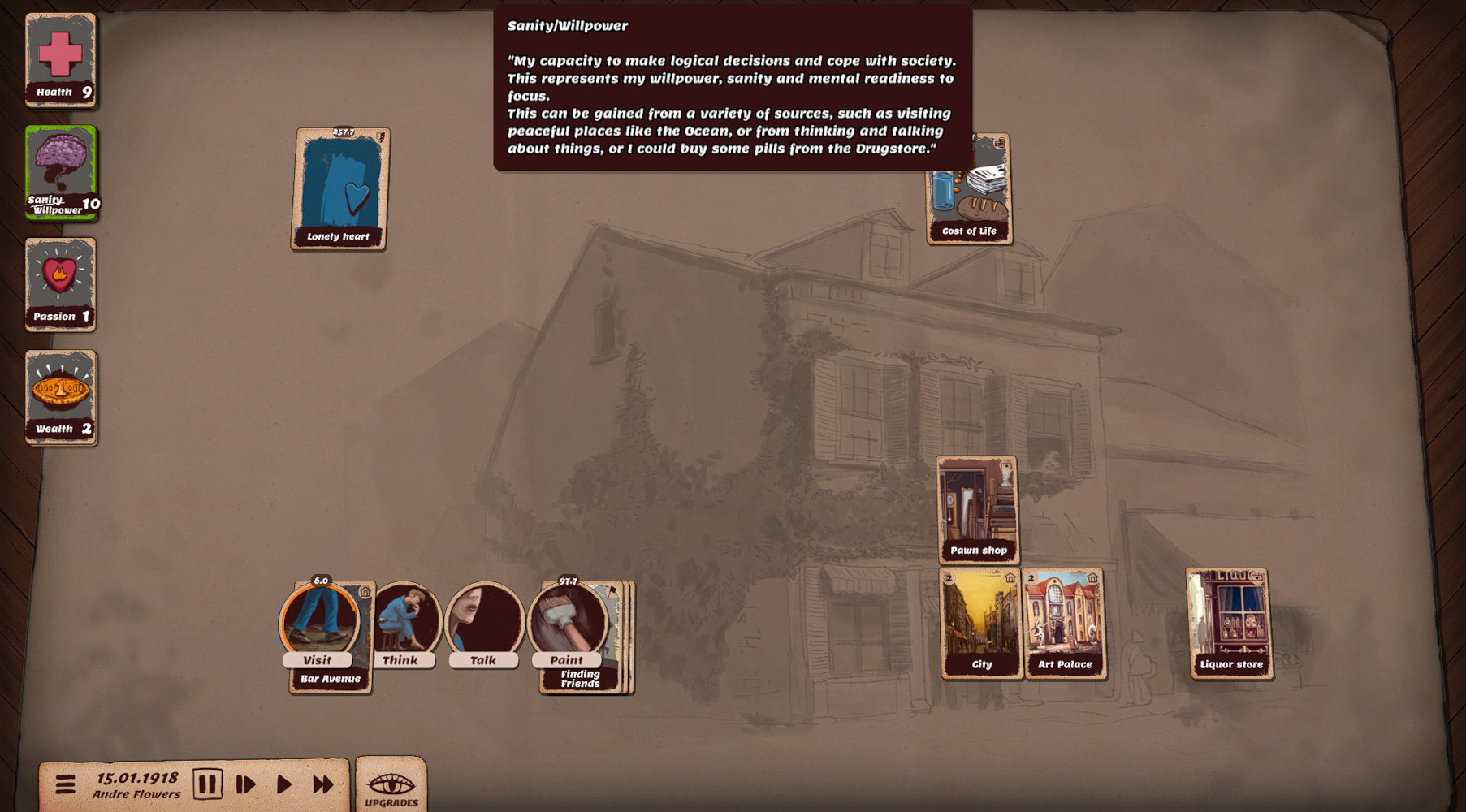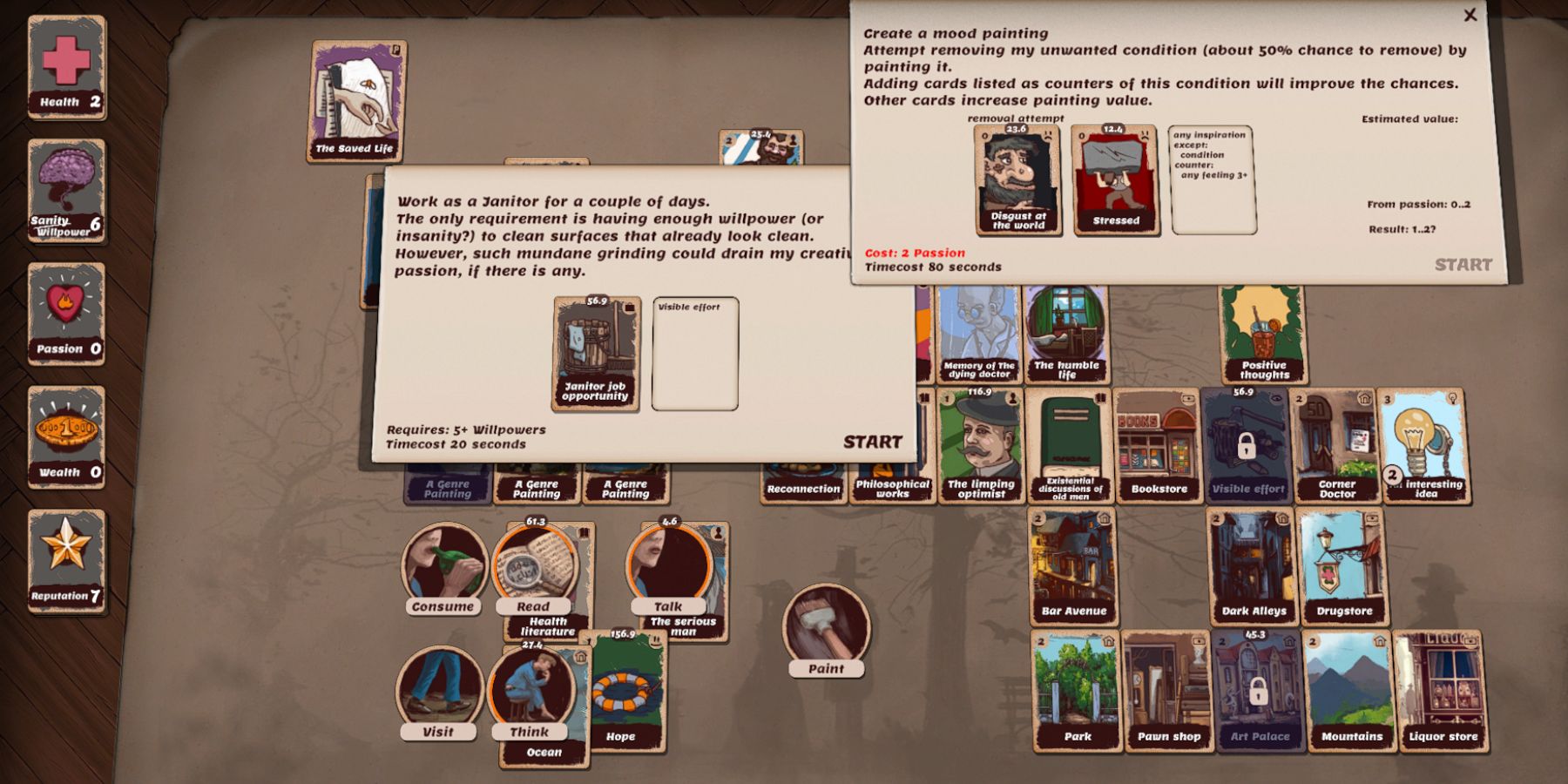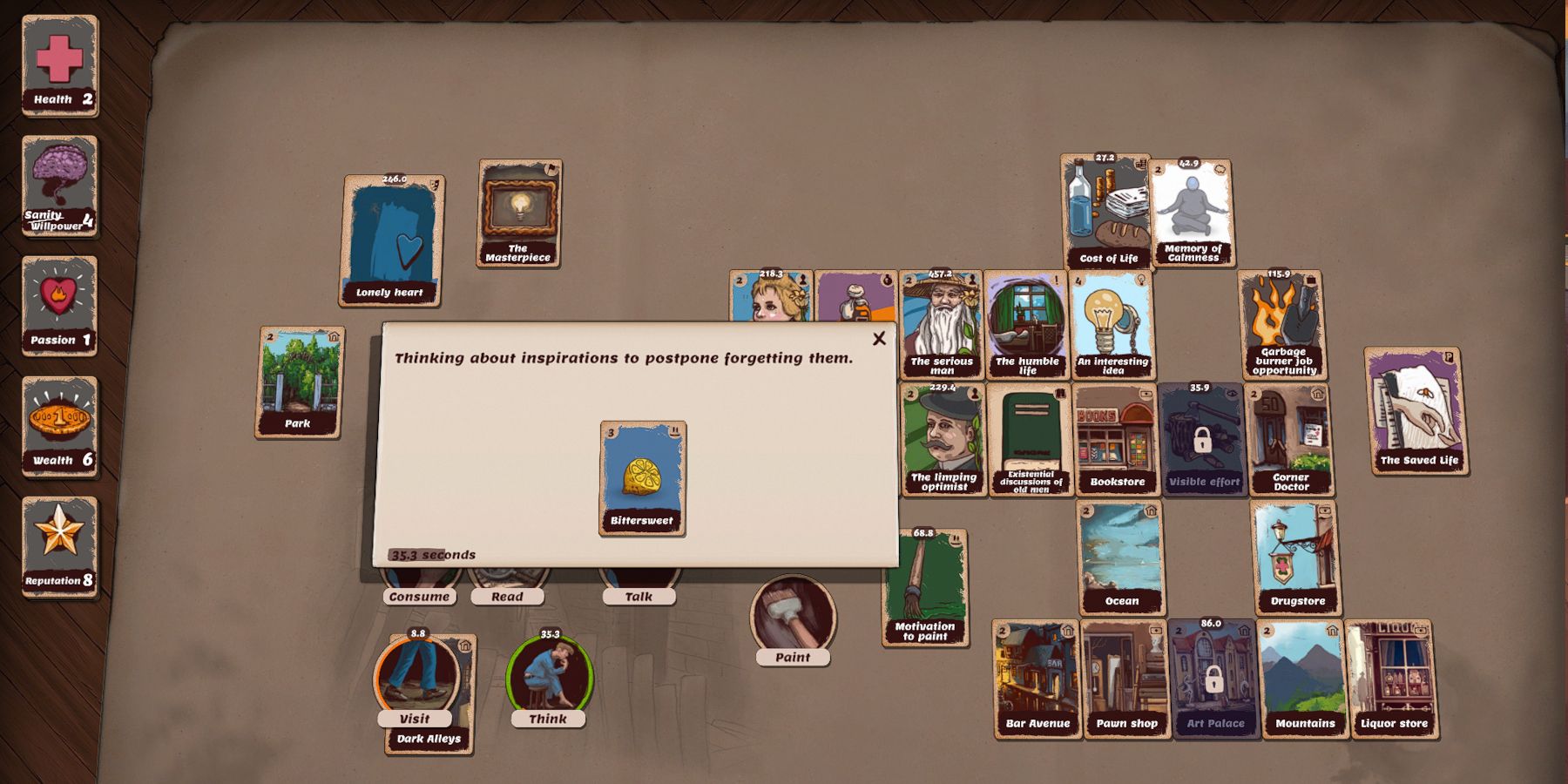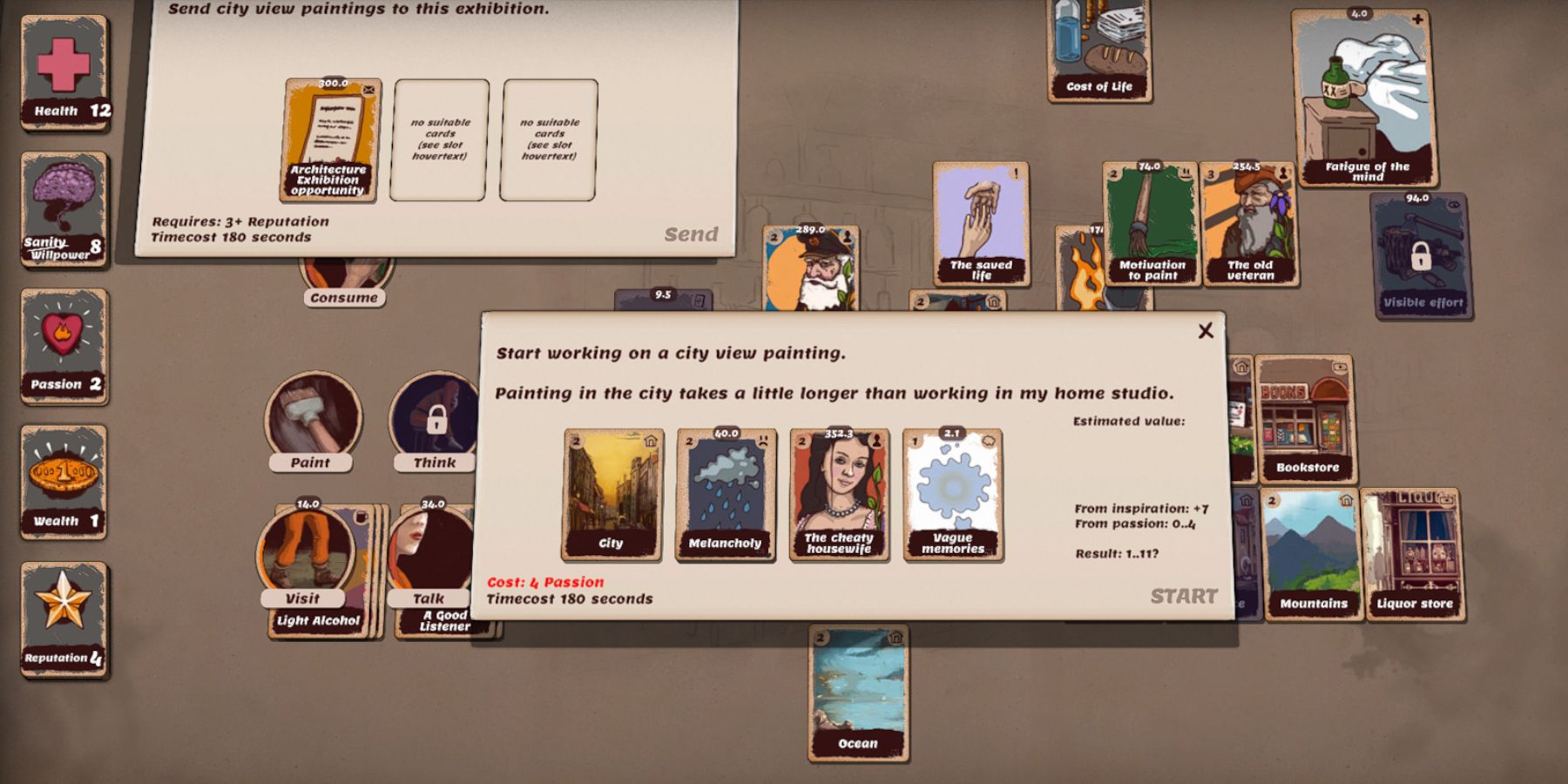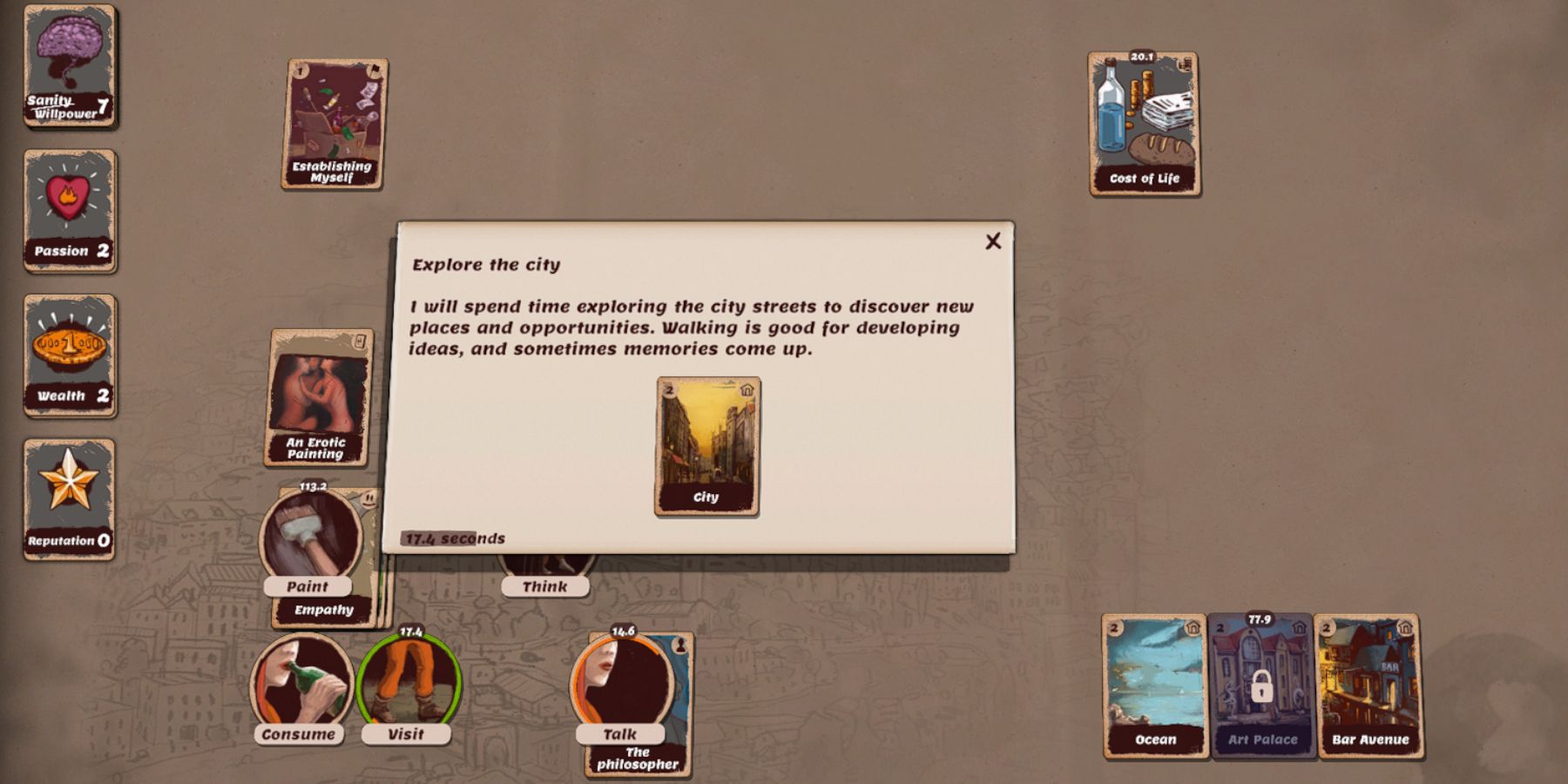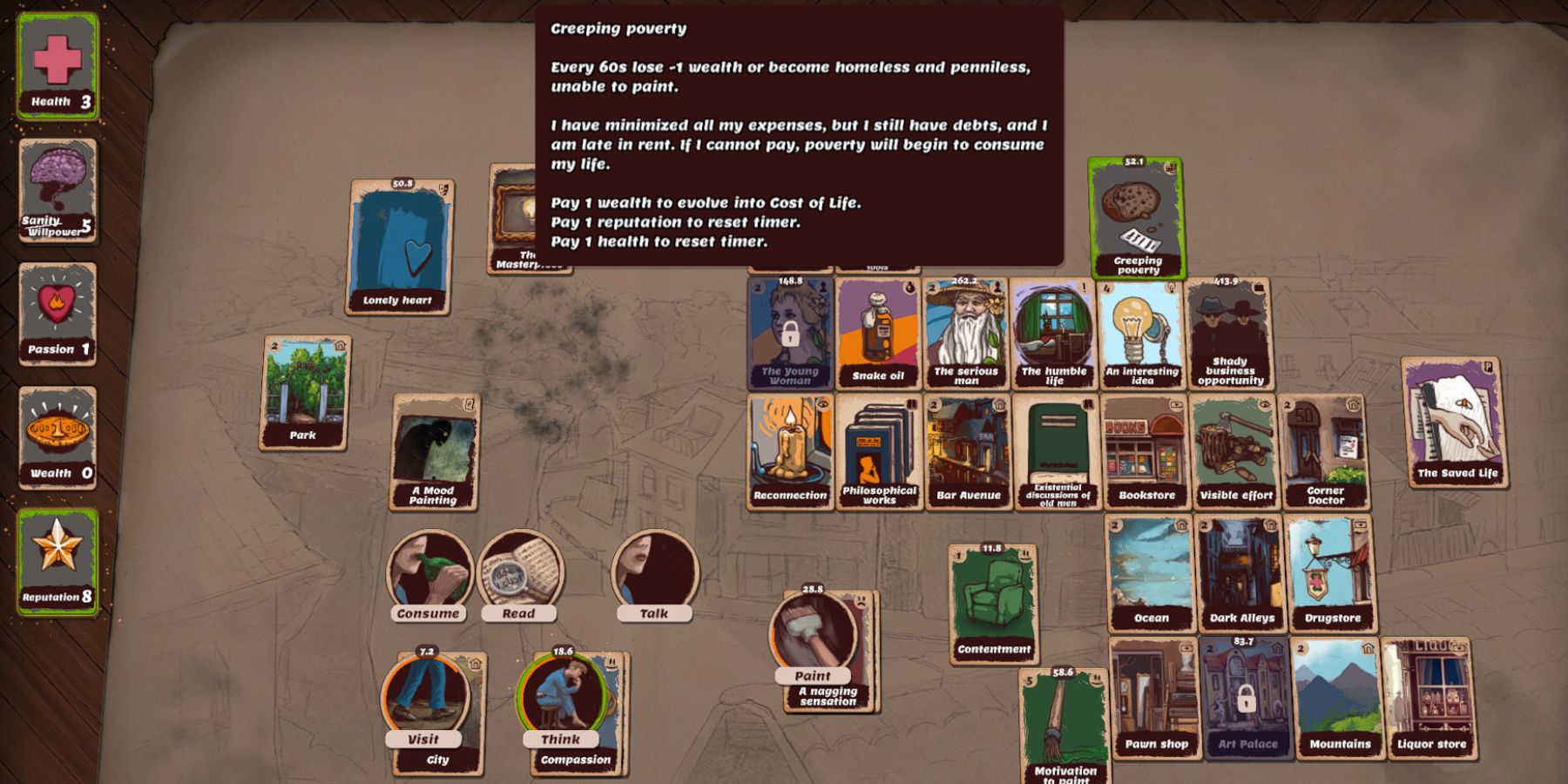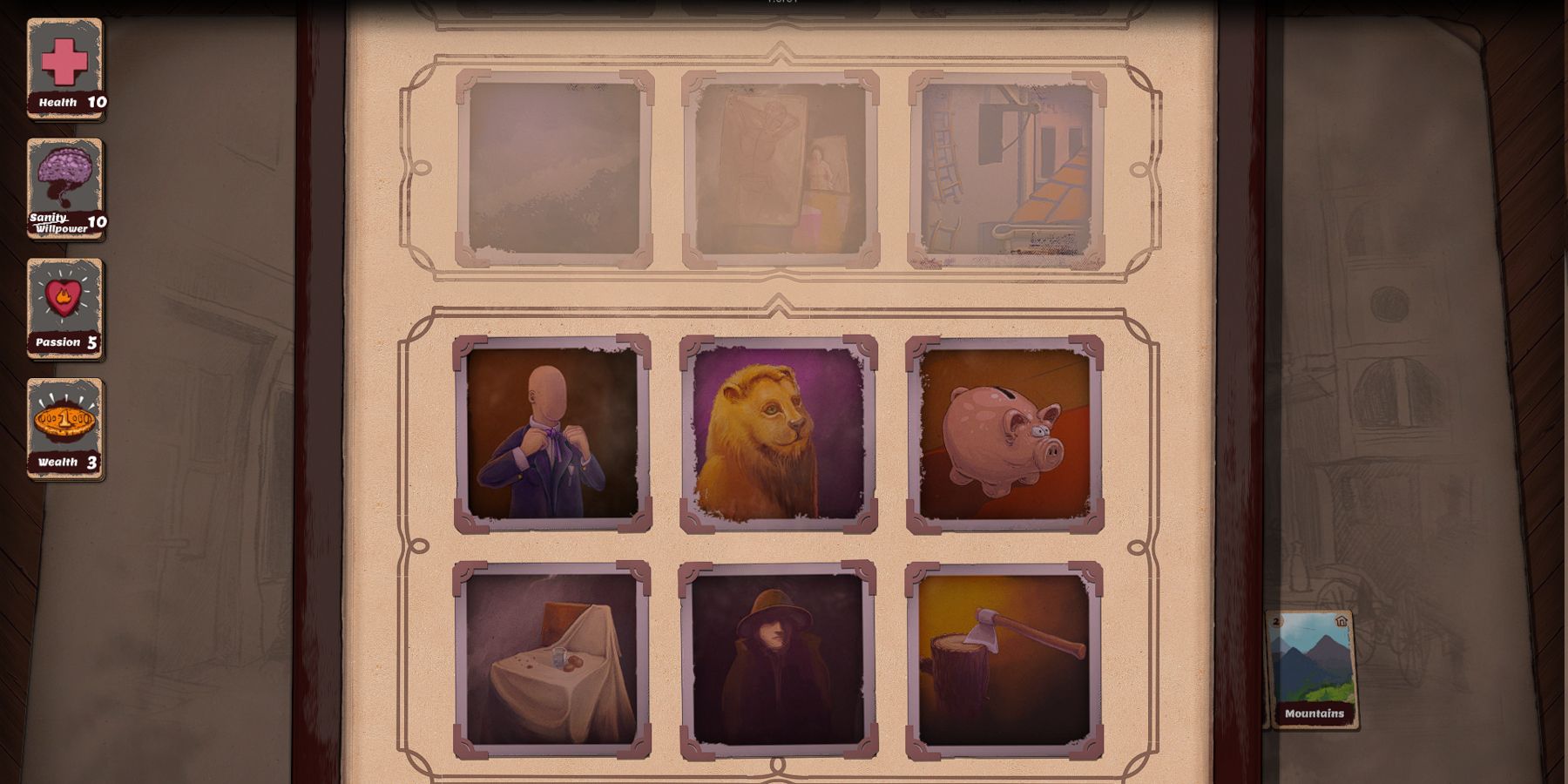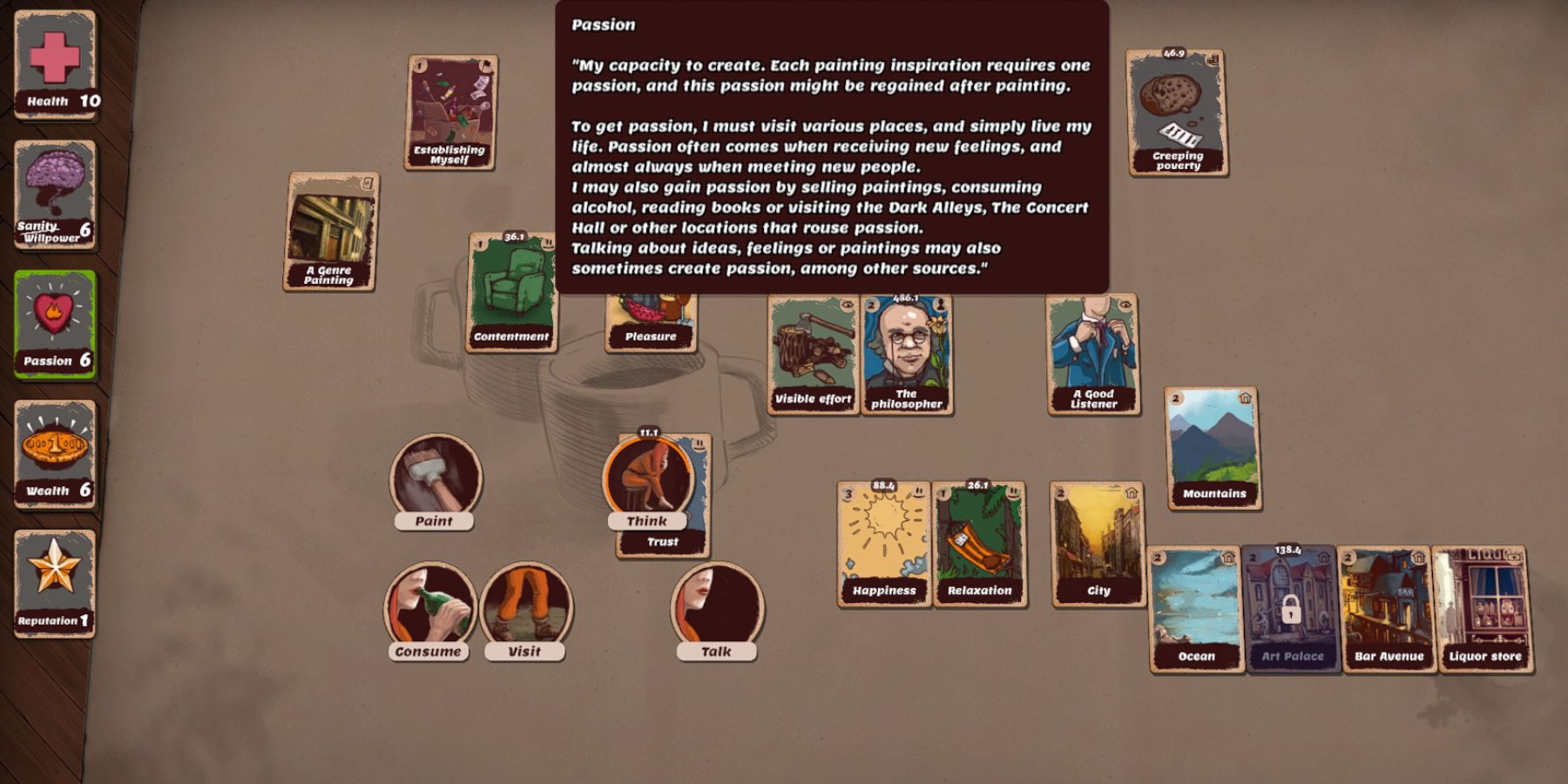Artist Life Simulator is an adventure game that casts you as one of four artists in Nova Oportunia, a city based on an alternative history 19th Century Europe. The game tasks you with finding fame and uncovering Oportunia’s secrets, all from a card-based verb-and-noun interface. It appears very lavish with a number of well-painted cards.
Beneath that pleasant exterior lurks a difficult adventure game experience. Actions have functions that must be discovered, negative conditions stack quickly, and before you know it, your chosen artist is out on the street. While the game encourages exploring with trial and error, figuring things out is daunting. Still, with the right tips, you’re bound to find things more intriguing than upsetting.
10 Prepare To Lose
If there’s anything you should know up front, it’s that Artist’s Life Simulator is difficult. Sometimes (much like its close relative Cultist Simulator), negative conditions and loss states pile up without a good way to heal them. Since Artist’s Life Simulator is a digital card game, luck of the draw is just going to be a part of the process, no matter how many tips or how much skill you have.
Remember that losing isn’t a bad thing, as you unlock new endings in the gallery and get rewards based on what happened in your last game. Don’t worry if it takes a few tries, even with hints and tips. You’ll get there.
9 Choose Your Starting Character Carefully
When starting a new game, the menu offers you four choices of starting character:
- Vincia, a young woman new to Oportunia
- Andre, a man who moves to Oportunia after the death of his mother
- Charles, an older gentleman with a drinking habit and a desire to be a full-time painter
- A “Mystery Artist” who acts as a random start
This is a difficulty selector. Vincia is the easiest with two paintings and good resources. Andre’s start is a little harder, since he has to manage a grief stat that generates negative emotions as well as all the normal resources. Charles has numerous expensive tastes that drain your resources, and also starts without any paintings to sell for early-game income. Each of these work out to “easy,” “medium,” and “hard” overall.
“Mystery Artist,” the fourth, is supposed to be a random difficulty, but it’s actually the second-easiest of the options, giving you a bunch of useful upgrades and none of the drawbacks of Andre and Charles.
8 Mouse Over Everything
Putting your mouse cursor over a card, resource, or action brings up a list of tips. These don’t just include what resources you can spend where, or even what the individual actions do, but also how to top up your health and sanity, gain money, and even which actions you can take.
Mousing over cards and actions also highlights any interactions between cards in green for you, a good visual aid when you need to plan your next moves. Finally, when you mouse over negative or positive feelings, the game shows what positive emotions can solve negative emotions. The best defense against the brutal RNG is lowering your amount of trial and error. The more you learn from the tooltips, the less you’ll have to worry about something going wrong at a crucial moment.
7 Hold Your Cards
An important technique is “holding” cards and events. While everything on the board has a countdown clock, cards’ countdowns pause when you put them into an action slot. Artist Life Simulator even takes this one step further: you can open multiple action windows at once.
As long as you don’t close the actions, you can slot in as many cards as you like, pause their countdowns, and wait until you can use them. While this does ensure your board will be a huge mess (and ruin whatever satisfying card arrangement you created), it will lighten the time pressure and give you precious extra seconds to take riskier actions.
6 When In Doubt, Think About Your Cards
The Think command is one of the most useful tools on the table. Not only can it hold practically any card (and freeze its countdown), but it’s an easy way to refresh countdowns and get rid of negative conditions. You can even use it on your Cost of Living card, possibly giving you more time on your most consistent time pressure.
Using Think on your negative conditions alone has a chance to get rid of them entirely, but even if it can’t, it can still delay the countdown and with it, the negative effects. Think can also strengthen cards. When you use it on two feeling cards of the same color, you gain a much stronger card. Using it also unlocks the endgame conditions, which means it’s one of the two most vital actions – along with Paint – required to win the game.
5 Painting Is All About Timing
When using the Paint action, always check the time cost message at the bottom of the action slot. Painting negative emotions and landscapes takes more time than painting subjects, positive emotions, and idea cards. Since time is precious and every second counts, doing big paintings that take 180 seconds to complete takes a significant chunk out of your time in the early game.
Instead, go for lower-scoring cards, or upgrade the existing cards you have before slotting them into Paint, so you can save time when it counts and make the massive landscape paintings when you have the time and passion to give them the attention they deserve.
4 Take Frequent Walks
Another powerful move in your arsenal is using the Visit command. This is how you get inspiration, but more than that, exploring the city of Oportunia is how you get jobs, locations, and useful items.
Whenever you have a spare Visit command, be sure to put the City card in the slot. Sometimes you might be unlucky, but most of the time, you’ll receive something that can turn a losing game into a narrow escape with a little bit of work.
3 Creeping Poverty Gives You A Reprieve
If you’re low on cash and that Cost of Living timer reaches zero, don’t worry. It’s not as bad as it seems. Once timer reaches zero, the card turns into Creeping Poverty and you have another 60 seconds of game time to find a source of Wealth and get yourself back in the game.
As long as you can find some way to make a quick penny that will let you survive just a little longer. You can visit the City or Bar Avenue with your lower-value paintings, wander the city streets using the Visit action on the city card to find a job or some random artifact to sell, or even hit up your acquaintances for cash using Creeping Poverty with the talk action to get a loan. So if you see the Cost of Living card change, don’t panic. You still have just enough time.
2 Master Perks
Artist’s Life Simulator has a rather unusual perk system hidden in the lower part of the screen, labeled upgrades. While it’s another thing that requires trial and error for some of its options, the requirements can be easily found if you click on the upgrades and mouse over their slots.
The two most important perks to get are The Memorable Impressions, which gives you access to the Good Listener perk and lets you save the crucial Passion resource when talking to people, and The Hard Worker, which gives you access to the Visible Effort perk to get a little extra money when you do part-time jobs. It’s worth playing around with, as some perks can even unlock endgame conditions
1 Hoard Passion
Passion is the most important resource in the game. It’s what you spend to paint, what you use on perks, and serves as a final milestone for an endgame condition. While Passion is a simple thing to pick up, it’s by no means easy to get, requiring you to paint with specific cards, have certain conversations, or chug alcohol by the gallon to refresh.
With the midgame and endgame requiring larger amounts of Passion, go for lower-risk scenarios or use Perks when you can to offset the consistent Passion loss, so you can save it for the times it really counts.


